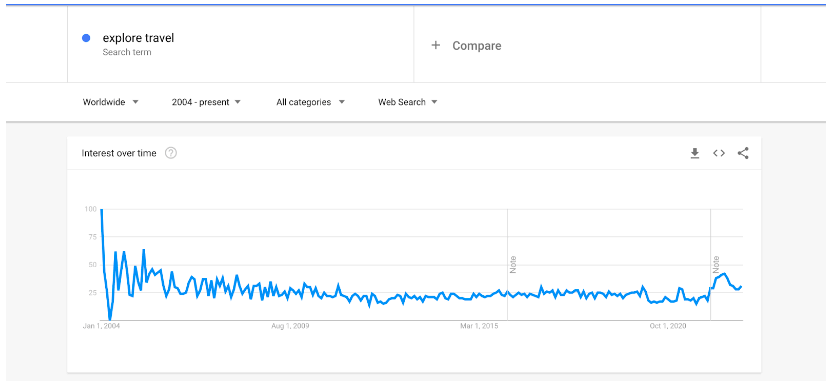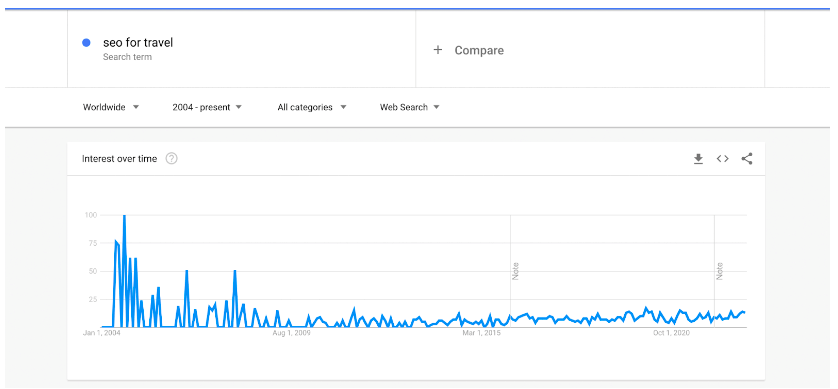Ready To Boost SEO For Your Travel Website? Here’s How.
Stand out with smart SEO for travel websites and start driving more organic traffic to your content and increasing your visibility.
Table of contents:
- Understand general need for SEO for travel websites
- Optimize for the right user intent
- Segment your customer journey into phases
- Enough talking, show me the SEO tips and checklist you have for me!
- OK but…is that everything? Any advanced SEO for travel tips?
- Conclusion
The travel industry made a big comeback last year in 2022. We have been waiting for this for quite a while, especially after COVID 19: I think we have all felt that we are missing that personal, vital connection with others around the world when we go on our usual vacations and business trips and our regular trips abroad.
The industry had faltered a bit, but we can slowly see it recovering over the last year and a half. If you look at the searches [“explore travel”], [“seo for travel”] (and of course you can include other searches), you can see that interest is slowly recovering.
Whether you own a travel website or are concerned about your hotel SEO strategy, Airbnb SEO plan or general accommodation SEO approach, you have come to the right place. Let us take a deep dive together.


Understand General Need For SEO For Travel Websites
People are different and therefore there is a whole range of ways they use to explore a place that might be interesting for them to visit. Google conducted a study, “Travel data&insight”, on travel and the reasons why people travel and found that about 20% of people book a trip to a place they have always wanted to visit, either recently or for quite some time. At the same time, 7% of respondents confirmed that they decided to travel because they were celebrating a special event or saw a discounted offer when searching online.
This is a great opportunity for you! These insights, combined with Google Trends data, Google Ads data and Google Search Console data, can be a powerful weapon for you to attract hot leads online and optimize your customer journey to drive more conversions online. There are several intents you can optimize for, but generally the most important are the navigation, information and transactional keywords you can optimize for:
- Navigational: exploring, navigating a website;
- Informational: tracking down a particular clue or piece of information on a particular website
- Transactional: purchase intent, especially important in SEO for travel websites.
Optimize For The Right User Intent
Transactional intent optimization is the most important to keep your business vital and healthy. But you need to find a way to get there.
Let’s start from the beginning. We have seen great success in conducting user interviews and surveying user focus groups about their user experiences in the early stages. This data is important because it helps you collect information about your initial user personas, develop their customer information trees and expand from there:
- Use keyword research tools;
- Scrape potential data from sites like Booking and Airbnb to get a feeling about which customers look for affordable prices and when people are willing to spend more;
- Use Reddit, Quora and forum-based websites to learn about your customers pain points;
- Inspect your top competitors on Google Maps to get an inspiration on where they are falling back to meet your target audience needs and offer something competitive on these fronts.
Segment Your Customer Journey Into Phases
- General phase: the customer wants to visit his place from his/hers dreams. He/She starts by typing some initial queries on Google or goes directly to a booking website;
- Search phase: travel itself is complex and it requires a serious financial investment, so accordingly, online searchers will spend researching multiple assets, travel advantages and disadvantages online before committing to an offer. This includes reading other customers’ reviews on Google Maps, analyzing room assets, flight and general transport details plus interesting places to visit. Now, you will realize it is more complex than just choosing a accommodation but rather it is about the whole traveling experience that will take place;
- Booking phase: the prospect is ready to become your customer and they are looking for the right payment method for them to do the money transfer to you;
- Exploring phase: the customers come to your travel space, experience their travel journey and if everything is OK, they may reward you with a few pictures on social media about your travel offer. Use this wisely! Ask for customer feedback on your website or your maps.
Enough Talking, Show Me The SEO Tips And Checklist You Have For Me!
- Optimize your Google Business listing with the right listings, images and customer reviews as we described in the previous step. The same goes for the reviews on your website. They are your engine for generating new customers, why waste or neglect them? Show the right NAPW information: Name, address, phone number and a website. Mention similar places nearby, interesting events in your neighborhood or iconic places worth visiting. Boost your local SEO like never before!
- If you have a complete offer, you can use the discounts code schema markup. This is best accomplished when you start with the main schema markup Offer, because it is simply the most appropriate schema markup when you are offering a coupon code. Structured data is a real asset to your website: Combine it with LimitedAvailability, availabilityEnds and priceSpecification and you are good to go!
- Is your website mobile-friendly? Do you have a satisfactory speed (score) to deliver your content to your end users as fast as possible? No? Then you should hurry up, because it’s time to change that! It’s always a good idea to hire a dedicated developer to help you improve content delivery and optimize your code for the perfect speed, so you can actually deliver the best online experience possible;
- Are your links and content columns placed correctly? Then sit down with your content writers and think about what kind of landing pages you can design and describe based on user intent. People are always willing to explore not only your offer, but everything else. Semantic links are important. So use your SEO tools and SEO dashboards to figure out which pages are worth linking to in order to improve your internal PageRank and boost your organic performance;
- Are your photos of the highest quality? It’s always a good idea to work with a Google-verified photographer who will enable your website to present your online business in the best possible light. Quality is important because people want clean, comfortable places to spend time with their loved ones or family. High-resolution photos are always welcome, they are like a virtual tour of your accommodation. Use this to your full advantage!
Ok But…is That Everything? Any Advanced SEO For Travel Websites?
We were waiting for you to ask that. Of course not! We cannot properly conclude this topic unless we include the mix of knowledge graphs and structured data in your travel story.
We have already reported that some of the biggest tech giants like Google, Microsoft, Yahoo and Yandex have joined forces to develop the most appropriate descriptors for web pages in the form of schema markup. This time, it’s not just about providing the data for analysis, but actually getting high-quality data ready for further processing and structuring. The value of proper semantic descriptors (structured data markups) is that you can properly explain and disambiguate your content from that of your online competitors. In an age where content is growing exponentially, it’s no longer enough to simply publish it. You must provide structure, semantic logic and content organization so that your content can be easily found when searching the Web.
You can also structure your content by extracting entities from your content and then organizing them into a content catalog with different entity types, where all entities are connected by semantic relationships. This will help you deepen your search and explore other facts about your entities through a knowledge graph that may not have been so obvious before.You can ask questions like:
- “Who is the owner of the travel agency X?”;
- “What is the capital city of Austria” (for example);
- “What are the most common countries among my guest lists”;
- “Which are the most connected entities to my main entity Y?“
This is hard to obtain properly unless your data is not organized in some sort of a database or a knowledge graph.
WordLift has developed a software that allows you to add structured data and build your Knowledge Graph to further advance your travel SEO strategy.
In addition, WordLift recently released a Google Looker Studio connector that allows you to measure and analyze the performance of your semantic SEO strategy by collecting and combining data from different sources (GSC, Knowledge Graph, etc.) in one dashboard. Try it out!
Conclusion
Finally, enjoy your time with your guests. Use their experiences, take notes on what can be improved and strive to improve your offering, both online and offline. Great job is a great job, good work is always appreciated.
Bon voyage✈️🧑✈️